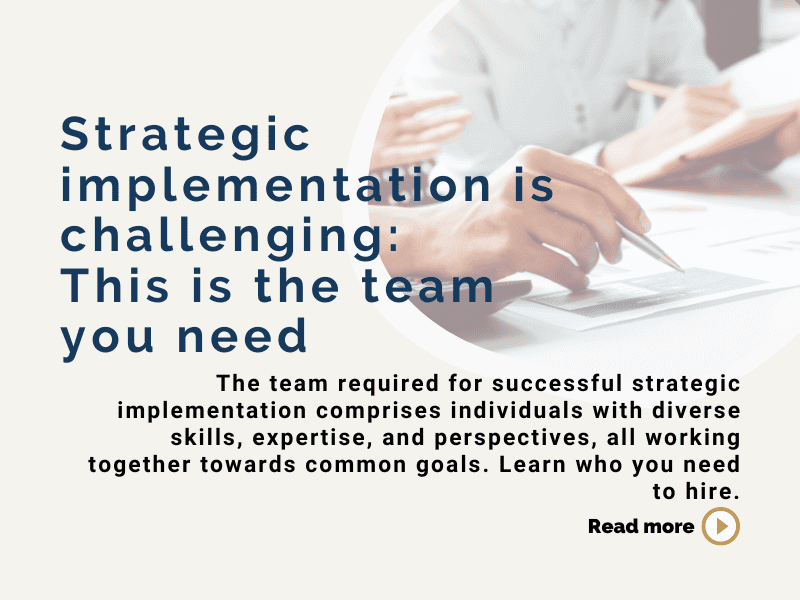FACT: Strategic implementation can be challenging due to the complexity of the tasks involved and the need for a cohesive team to execute the plan effectively.
And as a business owner, you have to be across everything. But a team of proactive, productive and purpose-driven people will make your job as the CEO of your business a lot easier.
Here’s the team you need:
The team required for successful strategic implementation is made up of individuals with diverse skills, expertise and perspectives, all working together towards your goals.
In my latest blog, you’ll learn about strategic implementation and the dedicated team you need to leverage to overcome challenges, seize opportunities, and achieve your big vision and strategic objectives.
Challenges of strategic implementation – what are they?
Strategic implementation, while essential for achieving your business’s goals, often presents numerous challenges that you and your team must navigate.
Some of these key challenges include:
1. Resistance to change
Implementing strategic initiatives often requires significant change. This can pose a challenge for yourself and your team, and when it comes to change – there can often be resistance.
Employees may resist change due to fear of the unknown, uncertainty about their roles, or attachment to existing processes. Overcoming resistance to change requires effective communication, whole-of-business engagement and strategies that are led by you as the CEO.
2. Lack of alignment
Ensuring alignment between your strategy and strategic plan and goals, and your day-to-day activities is crucial for successful strategic implementation.
However, what can often happen is that businesses can face challenges in communicating the strategic vision effectively to the team and even clients. Misalignment can lead to confusion, conflicting priorities, and inefficiencies.
3. Resource issues
Adequate resources, including financial, human, and technological resources, are essential for implementing strategic plans.
However, businesses may encounter resource issues, such as budget limitations, not being able to find or hire the right people for the right roles, or outdated technology and tools.
All of these things can hinder progress and limit your team’s ability to execute the strategy effectively – and achieve your big vision.
4. Lack of flexibility
Strategic plans must be flexible and adaptable to changing market conditions, customer preferences, and other changes within your industry or business, and you need to be able to pivot quickly in response to unforeseen challenges, and likewise, when it comes to opportunities.
5. Strong leadership
As the CEO you are the leader of the strategy, strategic plan and strategic implementation – and your team and clients need to know you are stable in this role. But sometimes CEOs can face their own set of challenges – even if you are a good leader.
If you’re the CEO and you are also doing the strategic planning and implementing:
- You can become trapped in the implementing cycle, which means you may not be able to give your full attention to the role as CEO to focus on high-level activities that grow your business.
- You can spread yourself too thin and get overwhelmed with all the moving parts.
- You may have vision but not consider yourself as a natural-born organiser, which means creating a plan and processes to execute the plan can be challenging for you.
- You find implementation to be a busy, tiring, stressful, time-consuming, overwhelming, low-level task with constant expectations … This can mean you procrastinate implementation.
If this is you, it’s time to hire the right team, starting with an online business manager (OBM) to implement your strategic plan and goal for you so you can get on with being your best self as the CEO.
An overview of the team structure you need to high-quality strategic implementation
A highly successful team is essential for strategic implementation because they possess the skills, expertise, and commitment necessary to drive the execution of strategic initiatives.
Success in strategic implementation requires effective collaboration, problem-solving abilities, and a shared sense of purpose among team members.
A successful team can help you navigate the above challenges, and others that arise, while adapting to changing circumstances and leveraging their collective strengths to achieve the strategic goals and your big vision.
In the hierarchical structure of strategic implementation, each role plays a crucial part in achieving the business’s goals:
Here’s the team members you need:
CEO – Vision
The CEO, as the visionary leader, sets the overarching goals and direction for the business. They define the mission, values, and long-term objectives that guide strategic decision-making.
With a keen understanding of market trends and business dynamics, the CEO provides strategic direction and inspires the team toward a shared vision of success.
OBM or management team (includes an OBM) – Strategic planning and high-level implementation
The Online Business Manager (OBM) or management team is responsible for translating the CEO’s vision into actionable strategies and plans.
They conduct detailed strategic planning, identifying key priorities, allocating resources, and developing implementation frameworks.
The OBM oversees the execution of strategic initiatives, ensuring alignment with strategic objectives and driving high-level decision-making processes.
Employees, VA and/or contractors – Execute the implementation plan and day-to-day tasks
The frontline team, including virtual assistants (VAs) and contractors, are responsible for executing the implementation plan devised by the management team.
They carry out specific tasks and activities outlined in the strategic plan, focusing on achieving short-term objectives and milestones. Their efforts contribute to the overall progress of strategic initiatives and achieving the business’s targets.
Effective communication and coordination among these roles are essential for successful strategic implementation and performance – and that’s where your OBM will be your saving grace, especially if you are not the most organised person.
A note to solopreneurs about strategic implementation
If you’re a solopreneur, you own all three tiers as outlined above. But here’s the hot tip … as you expand your business and team, you will then move up to the next level until you get to the top and can solely be the CEO with management and execution teams.
This will then free up your time so you can pave the way to your big vision.
For now, strategic implementation for solopreneurs takes on a unique dimension as you navigate multiple roles within your business:
1. Managing all levels
As a solopreneur, you are essentially responsible for all three levels of strategic implementation including vision, planning, and execution.
You conceptualise the overarching vision for your business, devise the strategic plans to achieve your objectives, and then execute those plans on a day-to-day basis. This multifaceted role requires wearing different hats and juggling various responsibilities simultaneously.
2. Transitioning to the higher levels
As your business grows and evolves, you will reach a point where managing all aspects single-handedly becomes unsustainable and tiring.
That’s when you need to start expanding your team by hiring employees, contractors, or virtual assistants to delegate tasks and streamline your operations.
By gradually transitioning tasks to your team members, you begin to move up to the next level in the hierarchy.
3. Freeing up time for your vision
Delegating operational tasks to your team allows you to focus more on strategic vision and high-level decision-making.
Once you have your VAs and execution team, you then start to gather your management team with an OBM (online business manager).
With a capable team in place, you can then devote your time and energy to crafting and refining your business vision, exploring growth opportunities, and innovating new strategies to move your business forward.
This strategic shift from operational involvement to visionary leadership is instrumental in paving the path for long-term success and sustainability.
So where do you start with strategic implementation?
If you have the feeling that you need to move away from being a solopreneur or you’re already acting as the CEO and you need to reframe your team, now is the time to start.
Now is the perfect time to leverage your team, so start with one of these situations:
Upskill a team member:
If you already have a team, identify someone within your team who shows potential and a willingness to take on additional responsibilities. Invest in their professional development by providing training and resources to enhance their skills, capability and capacity.
By upskilling team members, you empower them to contribute more meaningfully to strategic initiatives and take on leadership roles within your business.
Contract a Virtual assistants (VA):
Virtual assistants (VA) can provide invaluable support by handling operational duties aligned to your implantation strategies. By outsourcing these tasks to a VA, you free up valuable time and resources that can be redirected towards strategic activities and higher-value initiatives. I can help you with these activities, so please reach out for a discovery session.
Engage an OBM with experience in strategic planning and implementation (like myself):
Consider partnering with an Online Business Manager (OBM) who possesses specialised expertise in strategic planning and implementation.
An experienced OBM, like myself, brings a wealth of knowledge and practical experience to the table, allowing you to leverage their strategic insights and proven skills. By working with an OBM, you gain access to strategic guidance, project management support, and process optimisation solutions tailored to your business needs.
This strategic partnership enables you to navigate complex challenges, drive sustainable growth, and achieve your long-term objectives with confidence and clarity.
Other relevant reading:
The OBM Advantage: How to unleash the hidden potential in your business
How to hire an OBM in your business
Ready to supercharge your implementation plan?
If you want to break the implementation cycle and like the idea of having an OBM to help you with strategic planning and implementation, then reach out and have a chat.
Why book a Strategic Planning Session?
In your personalised strategic call, we will delve into the landscape of your business, identifying your specific challenges, goals, and the results you want to achieve. This session is not just about understanding your needs but creating a roadmap to address your needs effectively.
What you can expect
Strategic implementation: Create a roadmap where the strategies are aligned with your vision.
Continuous improvement: Work out how to continuously identify opportunities for improvement, enhancement and growth.
Operational systemisation: How to streamline your operations for better efficiency, freeing up your time so you can focus on what matters most.
It’s easy to book
Ready to work together? Follow my simple three-step process to get started before our Strategic Planning Session:
- Fill in the Online Contact Brief form: Share some details about your goals, and we’ll tailor our approach to your unique needs.
- Book a Discovery Call: Schedule a call with me, Ee Zen Cha, to dive deeper into your objectives and explore how you can achieve them. Let’s connect on a call and have a chat about your business.
- Get started: If we are the right fit, we can get started straight away on your journey to success.






